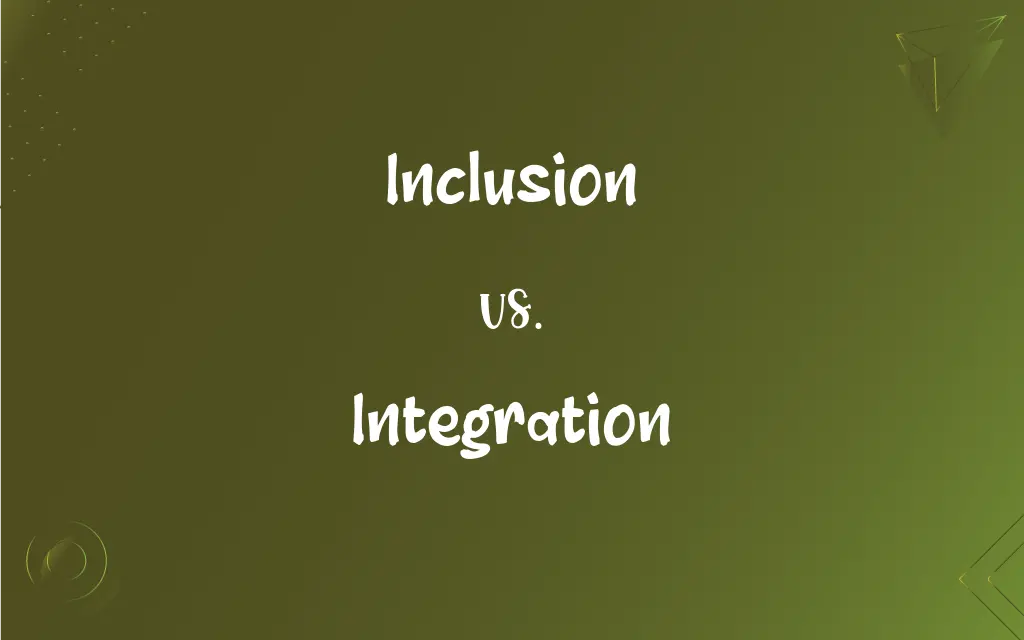Inclusion vs. Integration: What's the Difference?
Edited by Aimie Carlson || By Harlon Moss || Published on February 15, 2024
Inclusion involves ensuring everyone is accepted and supported, while integration is about incorporating individuals into existing systems or groups.

Key Differences
Inclusion is about valuing all individuals, ensuring everyone feels accepted, and fostering an environment where differences are respected. Integration, on the other hand, involves incorporating individuals into existing structures or groups, focusing on blending them into a pre-existing system.
Inclusion emphasizes the importance of creating spaces where everyone's needs are met and their contributions valued, irrespective of their backgrounds. Integration aims at combining diverse elements into a unified whole, often requiring individuals to adapt to established norms.
Inclusion seeks to remove barriers that prevent full participation, promoting equality and diversity. Integration, meanwhile, is about coordinating separate elements so they function together, which can sometimes overlook the unique needs of individuals.
Inclusion is proactive in adapting environments and attitudes to accommodate everyone. Integration often focuses on how individuals can fit into existing frameworks, which may or may not be fully inclusive.
Inclusion is an ongoing process of ensuring equitable access and participation for all. Integration focuses on merging diverse entities into a cohesive unit, which can sometimes lead to the assimilation of minority groups.
ADVERTISEMENT
Comparison Chart
Focus
Emphasizes acceptance and support
Centers on blending into a system
Approach
Adapts environments for everyone
Requires individuals to adapt
Goal
Promotes diversity and equality
Achieves unity and cohesion
Process
Ongoing, adaptive
Often a fixed process
Outcome
Equitable participation
Assimilation into a larger whole
ADVERTISEMENT
Inclusion and Integration Definitions
Inclusion
It refers to the practice of ensuring that people feel a sense of belonging in the workplace.
Her company's commitment to inclusion resulted in a diverse and collaborative work environment.
Integration
It refers to the incorporation of individuals from different groups into a society.
The school's integration policy helped students from various cultures feel more at home.
Inclusion
Inclusion is the integration of individuals from different backgrounds into a particular social setting or group.
The community center's inclusion strategy welcomed people from various cultural backgrounds.
Integration
Integration is the coordination of mental processes into a normal, effective personality.
Successful integration of her experiences allowed her to overcome personal challenges.
Inclusion
Inclusion is the provision of equal access to opportunities and resources for people who might otherwise be excluded.
The university's inclusion program provided scholarships to underrepresented minorities.
Integration
Integration is the process of combining or adding parts to make a unified whole.
The integration of innovative technology improved the efficiency of the business.
Inclusion
It's the action or state of including or being included within a group.
The new law promoted inclusion by mandating equal opportunities for all citizens.
Integration
Integration involves the combination of diverse elements of a group into a cohesive organization.
The team's successful integration led to a more unified and effective workflow.
Inclusion
Inclusion is the act of making all groups of people within a society feel valued and important.
The school's inclusion policy ensured that students with disabilities participated in all activities.
Integration
It's the act of opening something to people of all races or ethnic groups.
The company's integration initiative created a more diverse workplace.
Inclusion
The act of including or the state of being included.
Integration
The act or process of integrating.
Inclusion
Something included.
Integration
The state of becoming integrated.
FAQs
What is inclusion?
Inclusion is ensuring everyone feels accepted and supported in a group or society.
How does inclusion differ from integration in the workplace?
Inclusion in the workplace means creating an environment where all employees are valued, while integration focuses on merging diverse employees into the existing corporate culture.
How does inclusion benefit society?
Inclusion benefits society by promoting diversity, equality, and respect for all individuals.
How can schools promote inclusion and integration?
Schools can promote inclusion and integration by implementing policies that respect diversity and encourage participation from all students.
What is an example of inclusion in a community?
An example of inclusion in a community is a local festival that celebrates the cultural diversity of its residents.
Can inclusion exist without integration?
Yes, inclusion can exist without integration, as it focuses on acceptance and support regardless of whether individuals are fully integrated into a system.
What does integration mean?
Integration is the process of incorporating individuals into an existing system or group.
Is integration necessary for inclusion?
While integration can facilitate inclusion, it's not always necessary. Inclusion is more about creating an accepting environment than just merging individuals into a group.
What are some challenges of integration?
Challenges of integration include potential cultural clashes, resistance to change, and the difficulty of altering established systems.
How is inclusion implemented in policy-making?
Inclusion in policy-making involves creating laws and regulations that ensure equal opportunities and representation for all groups.
How does inclusion impact mental health?
Inclusion positively impacts mental health by promoting a sense of belonging and reducing feelings of isolation.
What is the difference between integration and segregation?
Integration involves combining diverse groups, while segregation is the separation of groups based on differences.
What are practical steps to achieve integration in a multicultural society?
Practical steps include promoting intercultural dialogue, ensuring equal opportunities, and implementing inclusive policies.
Why is inclusion important in education?
Inclusion is important in education to ensure that all students have equal access to learning opportunities and feel valued.
Can integration be forced?
While integration can be encouraged, forcing it may lead to resistance and negative outcomes. It's more effective when it happens organically.
What challenges does inclusion face in today's society?
Challenges include overcoming prejudices, breaking down barriers, and ensuring equitable treatment for all groups.
What role does leadership play in fostering inclusion?
Leadership plays a crucial role in fostering inclusion by setting an example of acceptance and actively working to create an inclusive environment.
Can integration lead to assimilation?
Yes, integration can sometimes lead to assimilation, especially if the focus is on conforming to existing norms rather than celebrating differences.
What are the benefits of integration in a business environment?
Benefits include a diverse workforce, increased creativity, and a broader range of perspectives.
How does inclusion differ in various cultures?
Inclusion may be expressed differently in various cultures, depending on social norms and values.
About Author
Written by
Harlon MossHarlon is a seasoned quality moderator and accomplished content writer for Difference Wiki. An alumnus of the prestigious University of California, he earned his degree in Computer Science. Leveraging his academic background, Harlon brings a meticulous and informed perspective to his work, ensuring content accuracy and excellence.
Edited by
Aimie CarlsonAimie Carlson, holding a master's degree in English literature, is a fervent English language enthusiast. She lends her writing talents to Difference Wiki, a prominent website that specializes in comparisons, offering readers insightful analyses that both captivate and inform.































































